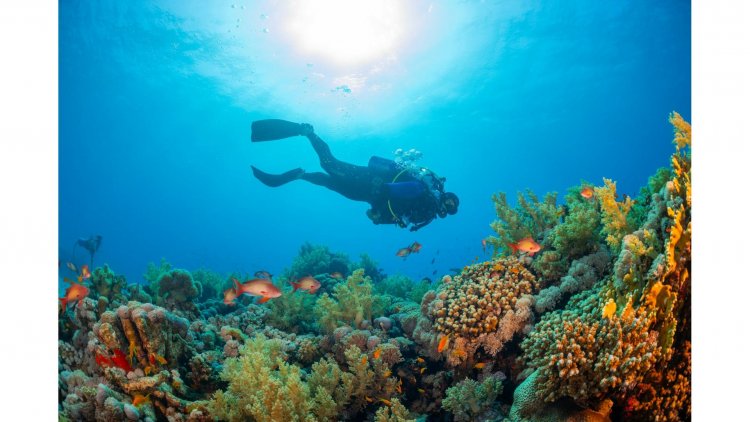Dive into Paradise: The Ultimate Guide to the Red Sea's Best Diving Spots
The Red Sea, with its stunning clarity and vibrant marine life, stands out as one of the world’s premier diving destinations. Stretching from the Gulf of Aqaba in the north to the Bab el Mandeb Strait in the south, this aquatic wonderland boasts a unique blend of breathtaking coral reefs, teeming fish species, and historical shipwrecks. For divers, the Red Sea offers an unparalleled adventure, promising everything from tranquil underwater gardens to thrilling encounters with majestic pelagics. Here’s a deep dive into some of the most spectacular diving spots the Red Sea has to offer.

Ras Mohammed National Park: Egypt’s Crown Jewel
A Marine Wonderland
Located at the southern tip of the Sinai Peninsula, Ras Mohammed National Park is a must-visit for any diver exploring the Red Sea. Established in 1983, this protected area is renowned for its incredible biodiversity and pristine coral reefs. The park’s underwater world is a haven for marine life, featuring over 200 species of coral and a staggering array of fish species.
Iconic Dive Sites
- Shark Reef and Yolanda Reef: This twin dive site is arguably one of the most famous in the Red Sea. Shark Reef, with its vertical drop-offs and vibrant coral gardens, is a hotspot for encountering large pelagic species such as oceanic whitetip sharks and hammerhead sharks. Yolanda Reef, located nearby, is known for its stunning coral formations and the remnants of a shipwreck that adds an element of intrigue to the dive.
- Anemone City: As the name suggests, Anemone City is renowned for its lush anemone gardens. This dive site is perfect for those who enjoy observing smaller marine creatures, including clownfish and various species of anemonefish, which find refuge in the colorful sea anemones.
- Ras Ghozlani: For divers seeking a more tranquil experience, Ras Ghozlani offers a serene dive among coral gardens teeming with life. The gentle currents here are ideal for drift diving, allowing divers to effortlessly glide past vibrant coral reefs and schools of fish.
Best Time to Dive
The optimal time for diving in Ras Mohammed National Park is between March and May, when water temperatures are comfortable, and visibility is at its peak. However, diving is possible year-round, with each season offering unique underwater experiences.
The Brothers Islands: Remote and Rugged
An Adventure Awaits
Located approximately 50 kilometers off the Egyptian coast, the Brothers Islands—Big Brother and Little Brother—are celebrated for their dramatic underwater topography and rich marine biodiversity. These remote islands are less frequented than other Red Sea dive sites, offering a sense of exclusivity and adventure.
Dive Highlights
- Big Brother: This island is renowned for its steep drop-offs and impressive walls covered in colorful coral. The highlight of diving Big Brother is the possibility of encountering large pelagic species such as tuna, sharks, and even occasional whale sharks. The famous wreck of the Aida II, a cargo ship that sank in 1957, lies near the island, adding an intriguing element to the dive.
- Little Brother: Little Brother is known for its sheer walls and rich marine life. The island is a prime spot for seeing schooling fish, including barracudas and jacks, and for witnessing the awe-inspiring sight of massive oceanic sharks patrolling the area. The coral gardens here are also spectacular, featuring a variety of hard and soft corals.
Best Time to Dive
The best time to visit the Brothers Islands is from June to September. During these months, the water temperature is warmer, and visibility is excellent, providing optimal conditions for exploring these remarkable dive sites.
Elphinstone Reef: A Thrill-Seeker’s Paradise
Dive into the Abyss
Elphinstone Reef, located off the coast of Marsa Alam, is renowned for its exhilarating dive experiences and encounters with large marine predators. The reef’s dramatic underwater topography features steep walls, deep drop-offs, and vibrant coral formations, making it a favorite among experienced divers.
Dive Highlights
- North Plateau: The North Plateau of Elphinstone Reef is famous for its strong currents and thrilling drift dives. Divers here have the chance to see majestic oceanic whitetip sharks, hammerhead sharks, and sometimes even the elusive thresher shark. The plateau's coral formations are also impressive, with a variety of hard and soft corals creating a vibrant underwater landscape.
- South Plateau: The South Plateau offers a different experience with its calmer conditions and stunning coral gardens. This area is perfect for observing smaller marine creatures, including colorful nudibranchs and a diverse range of reef fish. The South Plateau is also known for its excellent visibility and tranquil dive conditions.
Best Time to Dive
The ideal time to dive at Elphinstone Reef is from April to November. During these months, the water temperature is warm, and the visibility is excellent, providing the best conditions for encountering the reef’s larger marine residents.
Daedalus Reef: An Underwater Sanctuary
Remote Beauty
Daedalus Reef, located in the central Red Sea, is one of the most remote and pristine dive sites in the region. Its isolation has helped preserve its natural beauty and biodiversity, making it a true sanctuary for marine life.
Dive Highlights
- Daedalus Wall: The Daedalus Wall is renowned for its dramatic drop-offs and vibrant coral gardens. Divers can expect to see large schools of fish, including snapper and fusilier, as well as encounters with pelagic species such as oceanic whitetip sharks and hammerhead sharks.
- The Lighthouse Reef: The Lighthouse Reef is famous for its stunning coral formations and excellent visibility. The reef is home to a diverse range of marine species, including colorful reef fish and various species of rays. The Lighthouse itself, a historic structure that adds a unique element to the dive, is also a highlight.
Best Time to Dive
The best time to dive at Daedalus Reef is from June to September. These months offer the warmest water temperatures and the best visibility, ensuring a memorable diving experience.
Abu Dabbab: A Unique Ecosystem
A Divers’ Delight
Located near Marsa Alam, Abu Dabbab is known for its unique ecosystem and diverse marine life. This shallow reef system offers a different diving experience compared to the deeper, more dramatic sites found elsewhere in the Red Sea.
Dive Highlights
- The Turtle Reef: Abu Dabbab is famous for its resident population of dugongs, sea turtles, and other unique marine creatures. Divers can often spot green turtles and hawksbill turtles feeding on the seagrass beds, as well as the occasional dugong grazing in the shallow waters.
- The Coral Gardens: The Coral Gardens at Abu Dabbab are renowned for their vibrant coral formations and diverse marine life. The shallow waters and gentle currents make it an excellent spot for both beginner and experienced divers, with plenty of opportunities for underwater photography.
Best Time to Dive
The ideal time to dive at Abu Dabbab is from September to May. During these months, the water temperatures are pleasant, and the visibility is generally good, providing an optimal environment for exploring the reef’s unique ecosystem.
Fury Shoals: A Diver’s Dreamscape
An Underwater Odyssey
Fury Shoals, located south of the northern tip of the Red Sea, is a sprawling coral reef system renowned for its incredible biodiversity and pristine dive sites. This collection of reefs offers a diverse range of underwater environments, from vibrant coral gardens to dramatic drop-offs, making it a favorite destination for both novice and experienced divers.
Dive Highlights
- Sataya Reef: Often referred to as Dolphin Reef, Sataya Reef is famous for its resident pod of spinner dolphins. Divers can frequently encounter these playful creatures while exploring the reef’s vibrant coral formations. The reef also boasts a variety of marine life, including colorful reef fish, rays, and the occasional shark.
- Abu Galawa: Abu Galawa is renowned for its stunning coral gardens and excellent visibility. The shallow waters around this reef are ideal for exploring intricate coral formations and observing a wide range of marine species. The reef’s gentle currents and clear waters make it perfect for underwater photography.
- Sharm El Naga: This reef system features a series of sheltered bays and shallow coral gardens. It is an excellent spot for observing smaller marine creatures, including nudibranchs, seahorses, and a variety of reef fish. The calm conditions here are ideal for beginner divers and those looking to relax and enjoy the underwater scenery.
Best Time to Dive
The best time to visit Fury Shoals is from March to October. During these months, water temperatures are warm, and visibility is excellent, providing optimal conditions for exploring the reef’s diverse underwater environments.
Marsa Alam: A Gateway to Hidden Treasures
Discover the Wonders
Marsa Alam, located on the western shore of the Red Sea, is known for its stunning dive sites and unique marine life. This area has become a popular destination for divers seeking a more tranquil and less crowded experience compared to other Red Sea locations.
Dive Highlights
- Elphinstone Reef: As previously mentioned, Elphinstone Reef is a highlight of Marsa Alam, offering thrilling dive experiences and encounters with large marine predators. The reef’s dramatic underwater topography and diverse marine life make it a must-visit for any serious diver.
- Samadai Reef: Also known as Dolphin Reef, Samadai Reef is famous for its resident population of spinner dolphins. Divers can enjoy the unique experience of swimming alongside these playful animals while exploring the reef’s vibrant coral gardens and abundant marine life.
- Abu Dabbab: Abu Dabbab, with its unique ecosystem, offers divers the chance to encounter dugongs, sea turtles, and other fascinating marine creatures. The shallow waters and gentle currents make it an excellent spot for underwater photography and leisurely exploration.
Best Time to Dive
Marsa Alam is a year-round diving destination, but the best conditions are typically found from April to November. During these months, water temperatures are pleasant, and visibility is generally excellent.
Sharm El Sheikh: A Classic Destination
Iconic Dive Sites
Sharm El Sheikh, located on the southern tip of the Sinai Peninsula, is one of the most popular diving destinations in the Red Sea. The area offers a range of dive sites suitable for all levels, from beginner to advanced divers. Its proximity to several renowned reefs and wrecks makes it a central hub for diving enthusiasts.
Dive Highlights
- Ras Umm Sid: Known for its stunning coral formations and abundant marine life, Ras Umm Sid is a popular dive site for observing schools of fish, including snapper and grouper. The site’s gentle currents and shallow waters make it ideal for novice divers.
- Jackson Reef: Jackson Reef is renowned for its dramatic drop-offs and vibrant coral gardens. The site offers excellent visibility and the chance to encounter a variety of marine life, including sharks and rays. The reef’s impressive underwater topography makes it a favorite among experienced divers.
- The Thistlegorm Wreck: The Thistlegorm is one of the Red Sea’s most famous wreck dives. This British cargo ship, sunk during World War II, is now home to a variety of marine life and offers a fascinating glimpse into maritime history. The wreck’s large cargo holds and compartments provide ample opportunities for exploration.
Best Time to Dive
Sharm El Sheikh offers excellent diving conditions year-round, but the best time to visit is from March to November. During these months, the water temperature is warm, and visibility is generally at its best.
The Sinai Peninsula: A Divers’ Paradise
Exploring the Gems
The Sinai Peninsula, home to several world-class dive sites, offers divers a unique blend of underwater landscapes and marine life. From the vibrant reefs of Ras Mohammed to the historical wrecks of Sharm El Sheikh, the Sinai Peninsula provides diverse and exciting diving opportunities.
Dive Highlights
- Ras Mohammed National Park: As previously detailed, Ras Mohammed National Park is a premier diving destination, known for its exceptional coral reefs and diverse marine life. The park’s protected status ensures that its underwater ecosystems remain pristine and vibrant.
- Na’ama Bay: Na’ama Bay is a popular diving location in Sharm El Sheikh, known for its accessible dive sites and excellent marine life. The bay’s sheltered waters are ideal for beginner divers and those looking to explore vibrant coral gardens and schools of fish.
- Sharm El Sheikh Reefs: The reefs around Sharm El Sheikh, including Ras Ghamila and Ras Nasrani, offer a variety of dive experiences, from shallow coral gardens to deep drop-offs. These sites provide opportunities to encounter diverse marine species and enjoy stunning underwater landscapes.
Best Time to Dive
The Sinai Peninsula is a year-round diving destination, with the best conditions typically found from March to November. During these months, water temperatures are comfortable, and visibility is at its peak.
The Red Sea offers a wealth of diving experiences, from the renowned reefs of Ras Mohammed to the remote beauty of Daedalus Reef. Each dive site presents its own unique features and opportunities, catering to divers of all levels and interests. Whether you’re seeking thrilling encounters with pelagic predators, exploring vibrant coral gardens, or discovering historical shipwrecks, the Red Sea promises an unforgettable adventure.
As you plan your diving journey, be sure to respect the marine environment and follow responsible diving practices to help preserve these stunning underwater landscapes for future generations. Dive safely and enjoy the incredible beauty of the Red Sea!
Disclaimer: The travel information and recommendations on this blog are intended for general guidance and inspiration. Conditions and regulations can change quickly, so please verify all details with appropriate sources before making travel plans. We are not liable for any errors, omissions, or outcomes resulting from your use of this information. Travel involves inherent risks, and it's essential to prioritize your safety and well-being. Always travel with adequate insurance and take necessary precautions.
What's Your Reaction?





















